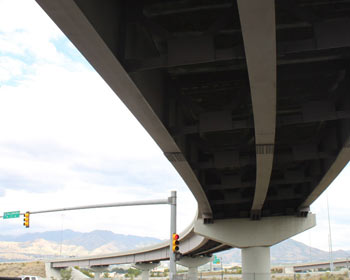MPC Research Reports
Report Details
Abstract
 The objective of this project is to find effective configurations for using buckling restrained braces (BRBs) in both skewed and curved bridges for reducing the effects of strong earthquakes. Verification is performed by numerical simulation using analytical models of existing bridges when BRBs are implemented for control of seismic forces.
The objective of this project is to find effective configurations for using buckling restrained braces (BRBs) in both skewed and curved bridges for reducing the effects of strong earthquakes. Verification is performed by numerical simulation using analytical models of existing bridges when BRBs are implemented for control of seismic forces.
The effect of ground motion incidence angle on the responses of skewed bridges retrofitted with BRBs in the bents is evaluated. A three-span skewed bridge with no retrofit was used as a baseline case. The assessment is carried out in OpenSees using a model that accounts for the BRBs between bent columns, abutment, and shear keys, as well as soil-structure interaction effects. The models are subjected to 21 farfield ground motions, and the maximum response under 11 incidence angles is obtained. The two components in each ground motion set are first rotated to their principal directions to minimize correlation among horizontal orthogonal directions. Thereafter, the ground motion components are scaled to the maximum considered earthquake (MCE) level.
The effect of pounding was investigated for curved bridges considering soil-structure interaction effects. A non-linear finite element model of the bridge was used to investigate structural pounding by performing time history analyses of strong motion earthquake records scaled to site conditions. Pounding between girders and abutments, between girders at expansion joints, and at shear keys was modeled when soilstructure interaction effects were considered using linear link elements. BRBs were modeled between girders and abutment, between girders at expansion joints and in the transverse direction at shear keys using non-linear links. Incremental dynamic analysis was used to assess the bridge performance under various earthquake scenarios with and without BRBs.
How to Cite
Pantelides, Chris P., Luis Ibarra, Yuandong Wang, and Anurag Upadhyay. Seismic Rehabilitation of Skewed and Curved Bridges Using A New Generation of Buckling Restrained Braces, MPC-16-315. North Dakota State University - Upper Great Plains Transportation Institute, Fargo: Mountain-Plains Consortium, 2016.

